News & Diary
Diary
11 August 2012
The Feeling of Homeland
Ulanda Blair
Since arriving in Urada, Andy has been learning as much as he can about the local food customs that are integral to the culture and livelihood of the Urada people. He has had first-hand experience in cultivating crops, and in preparing, cooking and serving regional dishes. He has foraged for edible plants in the surrounding bushland, and has been invited to sit at various dinner tables to share home cooked meals. Together these experiences have provided vital opportunities for him to explore the ever-shifting traditions, culture and identity of the Urada people, and to connect with the locals in a non-verbal way. In coming months he will compile photographic documentation, as well as drawings and other artwork created during his one-month residency, for a final exhibition and / or publication outcome.
The Feeling of Homeland (working title) culminated with Andy staging a collaborative performance event for the Japanese Ancestor Festival (Obon), on the forecourt outside of Australia House. Here he set up three tables in the shape of a triangle, which not only referenced Australia House and the ubiquitous tin sheds that dot the local landscape, but which also visually marked out the three different ways that food is traditionally handled in cuisines across the globe: raw, cooked and preserved. In this way, the triangular shape not only highlighted locally specific food preparation practices, but also subtly referenced the shared experiences that cross cultures, histories and continents. Likewise, Andy chose fried chicken (karaage) to be the centerpiece of his Obon meal, a dish that is not only a popular celebration food in Japan, but which appears in different cuisines, in different variations, all over - karaage is at once global and locally specific. Four local vegetable dishes taught to Andy over the course of his residency provided colourful and tasty accompaniments to the chicken.
The Feeling of Homeland performance was developed as a collaborative, participatory project. For three hours, every visitor that came to Australia House was invited to help prepare the food, approaching the triangular structure from the outside, and greeted by a local cooking "instructor" positioned on the inside. Visitors were encouraged to roll sticky sekihan (red beans and rice) into balls to make onigiri; to wrap the onigiri in nori seaweed; to crush black-sesame seeds and walnuts together to make a creamy salad dressing; to slice cucumbers into paper-thin disks for sunomono; and to wrap the freshly fried chicken in banana leaves and rice straw.
Children took up the invitation with gusto, while some adult visitors were more reluctant, apparently bewildered by the notion that were expected to help cook their own meal! It was a revelation for Andy to have his performance interpreted by some audience members as transgressive or challenging, particularly when in Australia participatory projects like this are generally perceived to be generous. In Australia, where more and more artists are experimenting with convivial models of being and living together, pursuing social transformation through art is not uncommon. Audiences are largely accustomed to these socially driven art encounters… or at least they are in the cities, where most of these projects take place. Andy's intention for The Feeling of Homeland performance was to relinquish his role as the single artist-author and to initiate a setting and context for gathering, sharing and learning. His project assumed different, unexpected meanings however in this rural Japanese context.
In Japan, there is the long held custom of hosting guests and of showing appreciation by the serving and gifting of food. For this reason, some visitors misinterpreted or overlooked Andy's artistic intentions for the project. As much as the visitors to Australia House clearly enjoyed their meal and each other's company as they sat, chatted and ate, the creative, relational and performative aspects of the event were not apparent to all. Andy had hoped that busy urbanites visiting the Echigo-Tsumari Art Triennale might use their Australia House visit as an opportunity to briefly stop, listen and learn from the local people who live off the land in Urada - as local cooking teacher Ogawa-san's t-shirt reminded people, "No Rice No Life". Unfortunately, many visitors were unreceptive to and confused by Andy's artistic and social concerns and were reluctant to collaborate.
The Feeling of Homeland was a steep but valuable lesson in cross-cultural engagement for Andy, and got him thinking about the intricacies of artist-audience relations in unfamiliar art and cultural contexts. As much as Andy was pleased with the performance and the way that it distilled ideas about local history, identity, ritual, cultural tourism and economic sustainability, he still came away from it with a raft of new ideas and new strategies for presenting similar art projects in the future. From speculative beginnings, Andy's one-month residency was tremendously productive and rewarding - a time where he tested his skills, took creative risks, forged unexpected relationships, established new cultural knowledge and took his artistic practice in unpredictable and exciting new directions.

Andy made his own
washi-paper lantern in the traditional
Obon colours. This lantern featured pictures of the four edible plants Andy had foraged for in preparing his Obon meal.

Tourists help prepare the feast under the careful tutelage of Urada resident Ogawa-san.
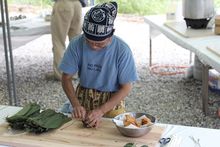
Ogawa-san's t-shirt imparted an important and often ignored message to Echigo-Tsumari tourists.

A local participant enjoying the final meal.
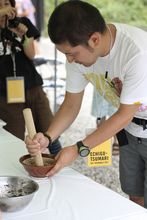
An Australia House visitor focusing intently on the task at hand.
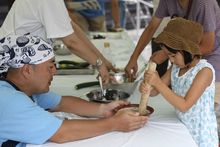
This young girl tried her hand at everything... her parents couldn't drag her away!
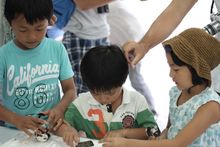
Children wrapping rice-balls in
nori to make
onigiri.

Participants literally "getting their hands dirty".
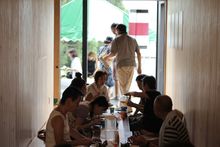
Strangers come together to enjoy their hand-prepared meal.

Andy's lantern was a gentle reminder about the beginning of
Obon, a time of gathering to honour the spirits of one's ancestors.
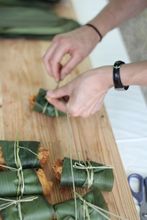
Wrapping chicken in banana leaf and local rice straw.
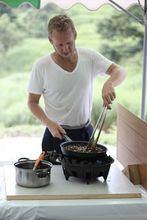
Master chef Andy preparing
zenmai, a local vegetable and delicacy.
News
11 August 2012
The Feeling of Homeland (working title)
Andrew Rewald
Australia House artist-in-residence Andrew Rewald invites everyone to join him for a special art and food event, in celebration of Obon.
Date: Saturday 11 August 2012
Time: 11:00 - 14:00
Venue:
Australia House
Urada 7577, Tokamachi, Niigata 942-1342
Website
Please drop in for a short time during these hours, Andrew warmly welcomes your involvement.
Diary
6 August 2012
Ladies who Lunch
Ulanda Blair
This afternoon Andy and Ulanda were invited to the Community Centre to have lunch with a group of local women who gather monthly to cook for their community. We first met Hisae-san, Izumi-san, Kimiyo-san, Sumie-san and Keiko-san at a BBQ up on Daigonji Highlands, the first week of our residency. On that day the local women fed us copious quantities of fresh goat, whilst Andy, Brook and Trent were force-fed sake… in the middle of a hot summer's day, no less!
Today the mood was much more intimate, where the women asked many questions about our families, and our lives in Australia. We compared our respective societies' treatment of the elderly, where in Japan the eldest sibling is usually tasked with staying in the family home and caring for their aging parents. For Hisae-san, this means that nine people currently live under her roof, in a household that spans four generations. We also talked about financial independence and the transition from childhood to adulthood, which (until the last decade, at least) seems to happen quite abruptly in Australia compared to Japan. The conversation naturally detoured into food and what constitutes Australian cuisine - a conversation that then wandered into a further discussion about Australian demographics and migration patterns. As Andy often explains to people, typical Australian cuisine is very diverse and is very much a product of our multicultural society.
We were very chuffed by the lunch invitation and flattered to have so much attention and interest bestowed upon us! We came away inspired by the ladies' camaraderie, familiarity and exuberance, and on our drive home discussed the possibility of starting our own cooking groups in Melbourne.
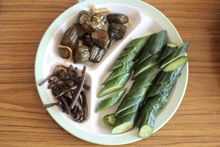
Pickled
kyrabuki, pickled cucumber and fresh cucumber.
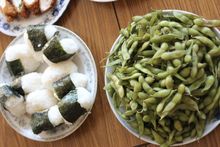
Crumbed chicken,
onigiri rice balls and
edamame boiled soybeans.
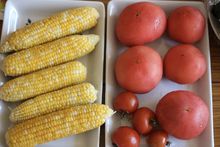
Home grown corn and tomatoes, the sweetest things.
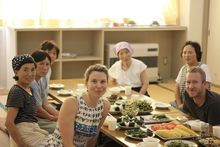
Lunch at the Urada Community Centre, clockwise from front: Ulanda, Hisae-san, Izumi-san, Kimiyo-san, Sumie-san , Keiko-san and Andy.
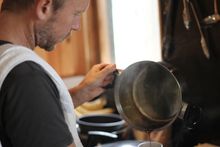
Andy boiling up bush herbs to use as pigment for painting.
Diary
31 July 2012
Living from the Land
Ulanda Blair
Today Andy undertook a cooking lesson at the home of Seiji-san and his wife Take-san, who are renowned agriculturists in the region. Seiji and Take demonstrated the cooking of traditional local summer dishes using 100% fresh produce from their plantations, including eggplant, cucumber, sticky rice, azuki beans and zenmai (a type of bracken fern that grows wild in Urada). They made sekihan (sticky red rice) from the homegrown rice and beans… even the miso (fermented soybean paste) was homemade!
Seiji is slowing down now being in his late 70s and he is unable to maintain his gardens as before. He apologized for serving store-bought sesame seeds and sheepishly confessed to now only growing 30 different crops in his 1-hectare plot, including rice... kandoushita (impressive)!
Take-san also told Andy how important it is for her to eat the local dishes that remind her of their ancestors who have been in the Urada area for 400 years. As Andy prepares for his Obon (Ancestors) Festival event, these insights were invaluable.
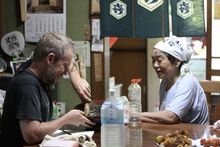
Andy learning how to make
Goma-ae, a black sesame, walnut and
miso paste dressing for a green bean salad.

Seiji cooking eggplant and peppers.
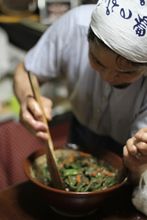
Take-san mixing
Goma-ae dressing into the salad.

Grinding black sesame seeds and walnuts for the
Goma-ae.
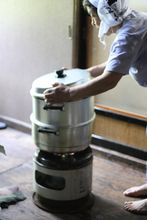
Take-san cooking rice and red beans.
Diary
28 July 2012
Australia House Opening Night
Ulanda Blair
A red carpet ribbon-cutting ceremony marked the official opening of Australia House, but it was the heartfelt karaoke performance by Gombe-san that really resonated with guests at the Australia House "housewarming" party, held on the eve of the 2012 Echigo-Tsumari Art Triennial.
The evening began at dusk with a traditional Japanese drumming ceremony by the 8 remaining students at Urada Elementary School. The school will close at the end of the year, which made the students' contribution to official proceedings all the more touching. Speeches from the Australian Ambassador to Japan, together with leaders from Tokamachi City, the Australia-Japan Foundation, and the Urada Community, all followed. For the Australians in the audience it was remarkable to see how an official Japanese ribbon-cutting ceremony is performed, where the dignitaries all donned white gloves, stood side-by-side, and undertook a carefully synchronized 'cut'.
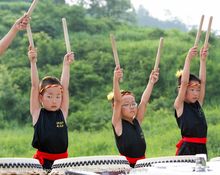
Urada Elementary School Students kick off proceedings with a traditional Japanese drumming ceremony.
Photograph: Brett Boardman
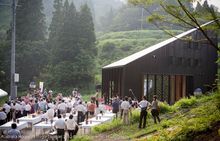
Tokamachi City Mayor Yoshifumi Sekiguchi addresses guests at the Australia House opening.
Photograph: Brett Boardman
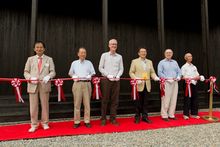
Australia House open for business. The official ribbon-cutting ceremony.
Photograph: Brett Boardman

Australia House architect Andrew Burns, wording up visiting dignitaries including Ambassador Bruce Miller (on right).
Photograph: Brett Boardman
The local women of Urada had been very busy in the day leading up to the opening party, preparing a gamut of local dishes to accompany the "Aussie Beef" provided by the Meat & Livestock Australia. This was an Aussie BBQ like no other, where onigiri rice balls, succulent pickled tomatoes, agedashi tofu, creamy kabocha pumpkin and soba noodles shared the plate with lashings of tender beef, soft white bread and tomato sauce! The Urada residents cheerfully manned the BBQs and ensured that nobody was left without a Coopers beer, a glass of Australian sparkling red, or some chilled sake.

Local Urada residents prepare for masses of hungry guests at the Australia House opening.
Photograph: Brett Boardman
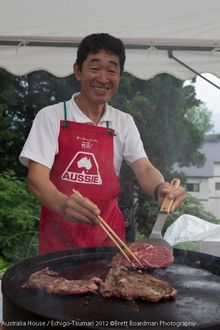
A happy local Urada local cooking the Aussie Beef.
Photograph: Brett Boardman
 Kanpai!
Kanpai!
Photograph: Brett Boardman
After another round of speeches, this time by the artists as well as by Australia House architect Andrew Burns, it was time to unleash Gombe-san. Gombe looked dashing in his grey suit and pink bow tie, armed with a robot-styled karaoke machine. In collaboration with Brook, Gombe chose two of his favourite folk songs to perform in front of Mountain Home - Dhirrayn Ngurang, the first Azamino Uta ("Flower Song"), the second Midori no Chiheisen ("Green Horizon"). Both songs spoke of the power and beauty of nature, and the importance of community and gathering. Gombe's performance was deeply poignant and moving and the crowd's applause could be heard across the surrounding mountains and valleys.
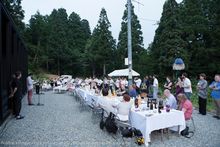
Andrew Burns addresses the crowd.
Photograph: Brett Boardman

Gombe-san breaks a heart or two.
Photograph: Brett Boardman
The final performance for the evening was orchestrated by Andy, and kicked off as soon as Gombe's performance ended. Sumie-san and her friend Mika diligently cooked fresh mochi on a makeshift burner outside the installation, whilst Andy stood beside them, adding his creative flourishes. Inspired by the triangular sheds that dot the Echigo landscape, as well as ETAT's distinctive triangle logo, Andy's mochi was (gasp!) triangular in shape. He wrapped it up in nori with a carrot and sesame omlette and steamed mizeu, and then served it on a purple shiso leaf with pickled daikon, beetroot and salted cucumber - all sourced from the surrounding land. Each tasty morsel was seasoned with a local miso paste dressing, and then served to the crowd from a wooden mochi-making board. Sugoi!
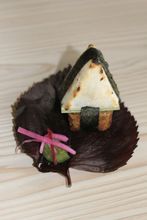
Andy's Mochi House!
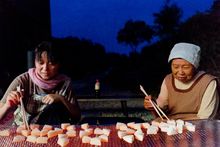
Mika and Sumie cooking mochi for Andy's special Australia House opening-night dish.

Andy roving through the crowd serving his mochi.
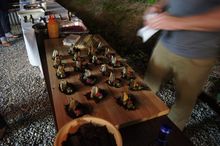
Ready, set, go! Andy's mochi, mere moments before being devoured.
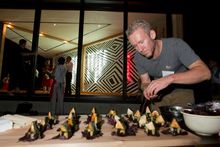
The artist at work.
Diary
23 July 2012
Mochi Mochi Man
Ulanda Blair
One dish that has been served to us repeatedly on our visits to our neighbours' house in Urada is mochi, a food with rich local, historical and spiritual significance. At Gombe and Sumie's house we have been served sweet mochi, savoury mochi, dyed green mochi and mochi wrapped in nori. Andy has decided to make his own special version of the dish for the Australia House opening. He has enlisted Sumie's help to learn how to make mochi from scratch.
Mochi is made from mochi-mai, a type of sticky, glutinous, short-grain rice. Because mochi-mai yields are usually low and quite a large quantity of it is required to make mochi cakes, it is traditionally considered a luxury dish that is eaten in times of celebration, often around the New Year period. Steamed mochi used to be manually pounded into mochi on the December 29; the vigorous pounding action was supposed to beat ku (suffering) into submission. (Interestingly, Andy and Ulanda were recently informed by local chef Mayu Hasegawa that end-of-year celebrations in Japan are often focused on forgetting the pain of the passing year!) Pounding mochi in a hollowed-out wooden log barrel with a big hammer used to be a backbreaking chore. It is still done manually this way in some parts of the country, however most people who bother to make their own mochi tend to use an electric mochi-pounding machine.
Andy visited Gombe and Sumie with his Australian friend Dom. Dom, with his fluent Japanese, acted as sous chef and interpreter. Dom's presence made the cooking lesson especially relaxed, fun and informative. Dom was able to convey aspects of Australian food culture to the couple, which up until now had been a mystery to them. They also learned about Andy's creative and conceptual interest in food. The exchange of information and knowledge was more balanced and reciprocal than it had been previously.
After the cooking lesson, Andy, Dom, Gombe and Sumie went foraging for sansai (forest vegetables) in the surrounding bushland. They picked mizeu from the hillside next to Australia House, which will be used in Andy's mochi dish for the opening night party.
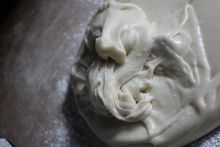
The freshest of fresh mochi.

Andy experimenting with mochi triangles. Dried mochi cakes are usually round in western and southern Japan, and square in the east and north, including Urada.

Andy's first attempt at making mochi all by himself.

Sumie gently stretching the mochi mixture onto a floured board, ready for cutting.
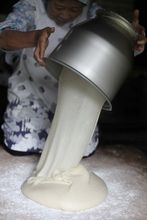
Sumie pouring freshly ground
mochi-mai onto rice flour.
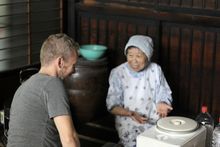
Sumie and Andy marvelling at the ease and efficiency of the modern, electric
mochi-mai grinder!
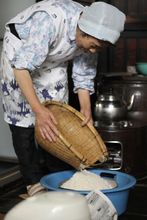
Sumie pouring freshly steamed
mochi-mai into a grinding bowl.
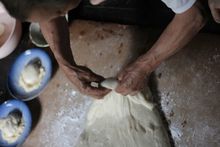
Gombe stretching out the fresh mochi mixture and tearing portions off.
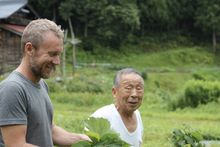
Andy and Gombe picking more
kyarabuki from their bushland backyard.

Andy at Sumie and Gombe's table, enjoying the fruits of his labour.
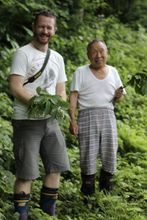
Andy's friend Dom, and Gombe, foraging for
mizeu around Australia House.
Diary
21 July 2012
Unveiling Mountain Home
Ulanda Blair
There was cause for quiet celebration yesterday when Brook's luminous white and red neon was finally installed, marking the completion of the installation.

Trent contemplating Brook Andrew's
mountain home -
dhirrayn ngurang.
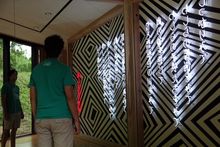
Trent contemplating Brook Andrew's
mountain home -
dhirrayn ngurang, close up.
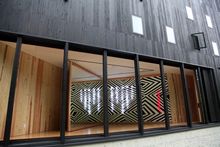
A wide view of Brook Andrew's
mountain home -
dhirrayn ngurang, taken from outside Australia House.
The neon text, written in Japanese kanji, is a haiku poem inspired by Brook's various interviews with Urada residents in March 2012. At this time Brook spoke with Echigo-Tsumari Art Triennale Director, Fram Kitagawa about the importance of communicating local thoughts and cultures through his work, especially for the benefit of out-of-town visitors. This conversation led to Brook asking the local people questions like "What are your favorite and most important community and ancestral traditions?" Conversations extended over many months and spanned topics as weighty as the changes in local culture following WWII, modernization and capitalism, spirituality, ceremony and humanity's relationship to nature. Parallels were drawn between the local Urada experience and the Aboriginal experience in contemporary Australia.
Brook wrote many poems in the process of making mountain home - dhirrayn ngurang. The final poem is a deep reflection on Urada, the struggle to thrive and survive in winter, the diminishing youth population, and the importance of ancestors, tradition and mountains to both spirituality and agriculture in the region:
see my snow, see my summer crop
see my jade river, see my mountain ancestors
see my children, see my struggle
see me with clarity
drink tea with me
The haiku text in mountain home - dhirrayn ngurang is written in reverse and so can only be read when the viewer gazes into the reflected image on the mirrored wall, a move designed to draw the visitor into the work and hence the lives of the locals. The final line of the poem (the only line that doesn't require deciphering in the mirror) is physically separated from the rest of the poem and is rendered in gently flashing red neon. As light tenderly pulsates through red glass casing, the visitor is invited to sit and stay a while, to drink tea and engage with the local people. One of the key lessons that came from Brook's interviews is that the local people really want visitors to engage with them - they don't want Australia House to be a tourist attraction where visitors take a quick photo and move on.

Trent approaching
mountain home -
dhirrayn ngurang from behind. The work is installed on a cantilevered panel which can be closed shut when other events and artworks are presented.

A close up view of Brook Andrew's
mountain home -
dhirrayn ngurang, taken from outside Australia House at dusk.
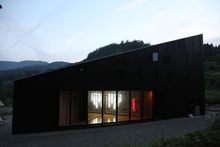
A wide view of Brook Andrew's
mountain home -
dhirrayn ngurang, taken from outside Australia House at dusk.

An elevated view of Brook Andrew's
mountain home -
dhirrayn ngurang, taken from outside Australia House, on the mountain.
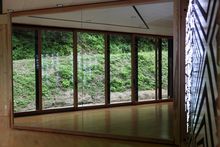
At Australia House the landscape is the fourth wall of the gallery; the mountains cradle the artwork.
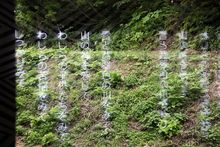
Brook Andrew's
mountain home -
dhirrayn ngurang immerses itself in the natural landscape that surrounds Australia House.
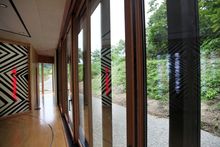
Brook Andrew's
mountain home -
dhirrayn ngurang, reflecting onto the glass doors of Australia House.
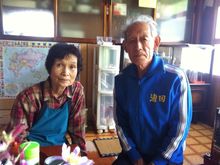
Brook interviewed fishing fanatic Ishizuka-san (pictured here with his wife) in the making of
mountain home -
dhirrayn ngurang.
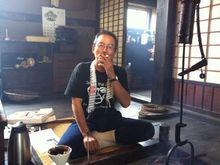
Brook interviewed 53 year old Shigeo Kogure-san in the process of making
mountain home -
dhirrayn ngurang. Kogure-san moved to Urada ten years ago and is considered a 'newcomer' to the area.
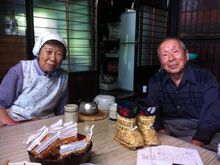
Brook interviewed 77 year old Gombe-san (Tomiyoshi Sato) and his wife Sumie-san in the process of making
mountain home -
dhirrayn ngurang.
Launched at the 2012 Echigo Tsumari Media Tour on Saturday 21 July, mountain home - dhirrayn ngurang was received very favourably by the Japanese media. A video interview conducted with Brook at this launch can be viewed here:
http://www.youtube.com/watch?v=JpCnisd4-Sg
http://www.youtube.com/watch?v=8pEwHYzHykw
Diary
19 July 2012
Trick of the Light
Ulanda Blair
Brook's installation is now almost finished, with Trent, Andy and Ulanda all pitching in to help with the expansive, geometric wall painting. Titled mountain home - dhirrayn ngurang, Brook's installation is inspired by his Wiradjuri (Indigenous Australian) heritage. The backdrop is a dazzling black and white diamond pattern that is traditionally carved into Wiradjuri people's shields and trees. Brook's use of this pattern is a playful interpretation of this cultural marker, and suggests Op Art aesthetics with its illusion of movement and vibration. The radial pattern is on the one hand arresting and spectacular, but it also contains potent, hidden layers of past and present ceremonial practice. The interaction between black and white in the flat geometric design is also political - the black and white forms retain their own identity at the same time that they are altered by their contrast. The pattern can, in this way, be considered as metaphoric of Australian colonization, and the complex, shape-shifting relationship between contemporary 'black' and 'white' people and cultures.
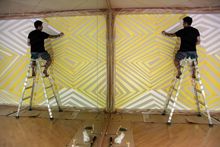
Double the trouble. A mirror image of Brook taping up (blocking out) sections of his wall drawing.

Brook busting out some action painting and customising his t-shirt at the same time.
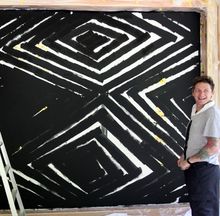
Brook looking happy with his work's progress.
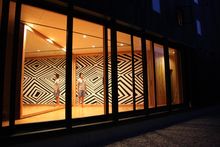
With the paint dry and the tape removed, Trent reflects on a job well done.
To celebrate the near-completion of mountain home - dhirrayn ngurang, the gang headed to James Turrell's feted House of Light for the evening. Commissioned for the first Echigo-Tsumari Art Triennale in 2000, this collaboration between US artist James Turrell and Japanese architect Daigo Ishii is both an artwork and a guesthouse. Trent and Ulanda were particularly excited to be staying at the House of Light, having each experienced Turrell's meditative, awe-inspiring installations on Naoshima, in Japan's Seto Sea, in 2010. Turrell's 'experiential' installations harness light and space to affect the viewer's body, eyes and mind. Informed by his studies in perceptual psychology and optical illusions, his art forces a renewed attention on light as a 'thing' in and of itself, rather than simply as a material to illuminate other 'things'.
Set high upon a quiet hill, House of Light was a house constructed in the traditional Japanese sukiya style, with a pillared verandah and gentle sloping roof. Incredibly, given the pre-Triennial peak season, the 4 of us managed to secure the entire house for ourselves, even though the place sleeps up to 16 people on futons and tatami. At sunset (7.04pm) and again at sunrise (3.25am!) we spent an hour flat on our backs gazing up through an aperture cut into the roof. LED lights, hidden around the rim of the 'skyspace', interacted with the naturally shifting sunlight to present a frame of pure, rich colour. This was an unforgettable experience.
After eating an enormous local-style dinner of snails, whole tempura-battered fish, crab, eggplant with red-bean sauce, savory melon jelly and more, we enjoyed a bath in the ground-floor hot spring. A simple fiber optic wire ran around the pool and doorframe, the only source of light, beside the little moonlight coming through a large window.
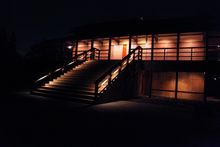
James Turrell's
House of Light, exterior view at night.
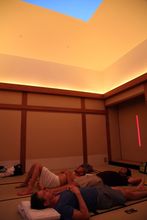
The beginnings of sunset as experienced through the
House of Light's 'skyspace'.
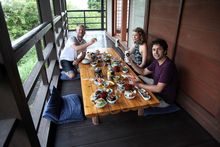
Andy, Trent and Ulanda tucking into a decadent, plentiful meal of local delights.
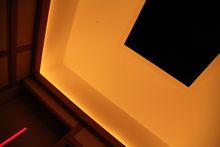
Sunset or day break? The end or the beginning? A view through the 'skyspace'.

The welcoming figure of Trent on the front steps of
House of Light.

Ulanda descending to the in-house onsen.

The shadowy figure of an artist bathing.

All was calm, all was bright.
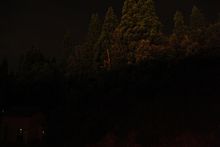
A very cinematic view from the bath.
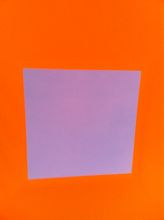 House of Light
House of Light sky view taken at approximately 4:00am.
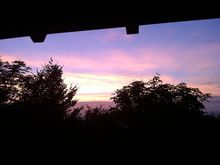
A 4:30am sunrise at
House of Light.
Diary
15 July 2012
Gombe-san, Karaoke King
Ulanda Blair
This morning we visited our closest neighbours, Gombe-san (aged 77) and his wife, Sumie-san. Gombe and Sumie live in a 160-year-old farmhouse, one of the oldest in the region. We had intended just to pop in and introduce ourselves, but before we knew it, two hours had passed and we had consumed our own bodyweight in mochi and tea! It was a wonderfully bizarre meeting.
Sumie was born in Urada and grew up in the same house that she lives in today. Gombe spent his formative years in a township 10 miles away. Theirs was an arranged marriage that seems to have been a balanced and happy one. Gombe is a self-confessed extrovert whose highly animated facial expressions and non-stop conversation expresses a lust for life. Sumie, with her calm demeanor and quietude, seems like a perfect foil for Gombe. With Daisuke's generous translating assistance, we were able to learn so much about their lives in Urada and the changes that have occurred here over the past 50 years.
From what we were told, it seems that in the years immediately following World War II, the social structure of the community changed dramatically. As Japan sunk into a recession, more and more people were forced into the cities in search of work. This has been the trend ever since, hence the depopulation of Urada and its surrounding villages.
We talked about the upcoming Obon Festival, which is a Japanese Buddhist custom to honour the spirits of one's ancestors. This custom has evolved into a family reunion holiday in the middle of August, during which people return to ancestral townships to visit family and clean their ancestors' graves. This August, Gombe and Sumie's two adult children will return home to Urada from Tokyo. Gombe lamented the fact that Bon-Odori, the traditional and localized dance that is performed by communities during Obon, has now largely been forgotten. Years ago, everybody in Urada would come together to celebrate Obon and eat, drink and dance together. These days Obon is a much more domestic, family affair. Andy is keen to present a performance or event during Obon 2012 that involves the broader Urada community.
Gombe is also a karaoke fanatic. He told us that performing traditional songs in a contemporary karaoke style, keeps him feeling fit and young. Gombe competes in regional karaoke competitions, many of which he has won. He showed us a DVD of him crooning karaoke tunes inside his farmhouse. This footage was shot in winter, when the snowfall makes it almost impossible to leave the house. Gombe's songs were inter-cut with romantic footage of he and Sumie traipsing through the snow-covered mountains, foraging for fukinotou, a green bud vegetable that is usually cooked as tempura. We all fell head over heels for this unique, generous couple and we are now hatching plans to involve them in the Australia House project.

Gombe-san, breaking hearts with his
karaoke renditions of traditional Japanese songs (DVD footage)
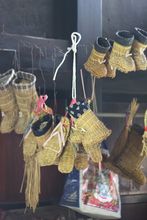
Gombe and Sumie's handcrafted snow boots, made from their own rice straw

Gombe and Sumie's house, behind Australia House in Urada
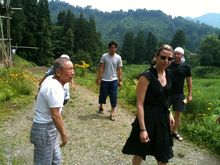
With Gombe

Sumi in the beautiful countryside of Urada
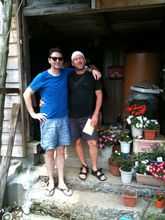
Brook and Andy on Gombe and Sumie's doorstep

After our visit we took our new friends to Australia House, where they enjoyed the view. Also pictured is Daisuke Goda, a friend of Ulanda's who came to visit from Setouchi.

Gombe and Sumie were delighted with the mirrored space in Australia House. Gombe later told us he would like to perform karaoke here. Watch this space...
Diary
13 July 2012
Taste Tests and Test Patterns
Ulanda Blair
We experienced our first earthquake last night! It lasted for less than 10 seconds, but was powerful enough to wake us up. We are sleeping on futons and tatami mats at the Community Centre whilst the finishing touches are being made to Australia House. The earthquake rippled through our bodies, giving us all quite a fright!
Andy had a productive day today. Back in Melbourne, Andy forages for native herbs and vegetables that grow in public spaces. This practice is a throwback to his farming heritage in rural Queensland, where, growing up, he learned various land management skills. Today Andy works as a chef as well as an artist. His art harnesses contemporary and traditional agriculture and food preparation practices to explore the connections between eating, personal identity, community, ritual and ceremony.
On our first morning here, Andy visited the top of the Urada Mountain with Daisuke Hatori, our artist 'housemate' who is originally from Tokyo, but who has lived in the US for the past decade. Daisuke is now based in Urada and is employed by the council to help revitalize the local community. Daisuke went foraging with Andy in the mountains, where they picked purple shiso, a fragrant Japanese herb that grows wild in the area. Upon returning to the house he whipped up a breakfast of soft fried egg on steaming rice with fine grated katsuobshi (sun dried and smoked bonito fish) and fresh vine-ripened tomato. Oishii oishii (yummy)!
Today Andy accompanied Daisuke to a nearby village, where Daisuke teaches English to the locals. Andy befriended Kazue, one of the ladies in the group. After her lesson, Kazue demonstrated different ways that the Echigo people prepare cucumber as a replacement for soup in the summertime. Andy made the same dish for our dinner, along with kyarabuki, a reedy vegetable that Andy foraged from around Australia House, and which Kazue gave him a recipe for.
Once the sun had set, Brook and Trent took a projector and computer over to Australia House to test the design for Brook's wall drawing and neon. It was exciting to see the space activated in this way. Brook's wall drawing uses a striking radial diamond pattern, which traditionally appeared on the shields and dendroglyphs (marked trees) of his Aboriginal ancestors, the Wiradjuri people. In Australia House, the projection created a really powerful, vibrating, kaleidoscopic effect. The mirror made the pattern explode in the space, extending it beyond the glass doors into the mountainous landscape. We can't wait to start painting!
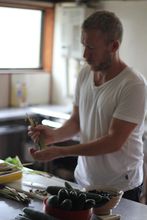
Productive day for Andy

Andy preparing kyarabuki for dinner

Katsuobushi Bonito for breakfast
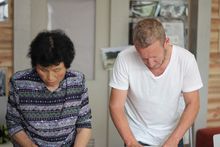
Kazue and Andy

Shiso
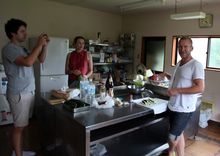
Trent, Ulanda and Brook at the Community Centre kitchen

Trent, Daisuke and Yasuko
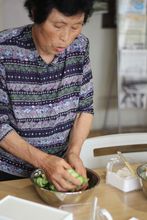
Kazue teaching Andy how to prepare cucumber and kyarabuki in the local style

Testing Brook's wall drawing design by projecting directly onto the panel
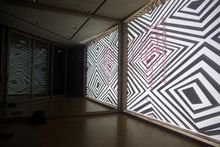
A house of mirrors! Testing for Brook's wall drawing
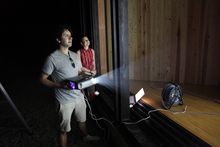
Trent and Ulanda experimenting with different layouts for Brook's wall drawing
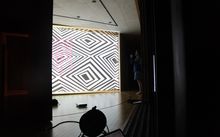
The tricks of technology! Brook playing around with different scales for his wall drawing, using a projector
Diary
11 July 2012
And So It Begins...
Ulanda Blair
Today we travelled from Tokyo to Echigo by Shinkansen. The trip was smooth and relaxing, and between us there was a quiet sense of anticipation for what lay ahead. As we strayed further and further from the dense city and urban sprawl of Tokyo, the landscape became strikingly lush, mountainous and green.
Yasuko Hayashi, our project coordinator from the NPO Echigo-Tsumari Satoyama Collaborative Organization, met us at Tokamachi train station and led us to Urada. Approaching the site by car, we were thrilled to finally glimpse the newly built Australia House in the flesh. It's soaring triangular structure, with its sharply sloping roof and jutting angular walls, really is a sight to behold. The building is hidden, tucked behind a sharp bend in the road, and so it comes as a complete surprise to find oneself suddenly in the presence of this spectacular edifice.
Inside, Australia House is light, warm and bright - it feels cosy and welcoming. There is an understated elegance to Andrew Burns' design, with elevated glass panels and natural timber surfaces sensitively and serenely assimilating with the verdant backdrop.
Brook was very impressed with the impeccable craftsmanship of his hinged wall on the ground floor of Australia House. For the Echigo-Tsumari 2012 Triennale, Brook will create an arresting wall drawing and neon-based text installation that references his own Wiradjuri heritage and tradition, as well as the stories of the local people of Urada. Titled dhirrayn ngurang (mountain home), the installation is a permanent but concealable fixture of Australia House.
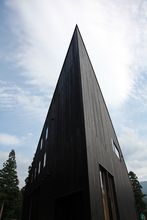
The spectacular, triangular Australia House, designed by Andrew Burns
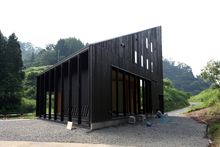
An elegant design
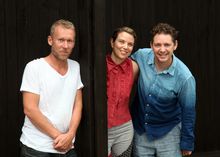
Andy, Ulanda and Brook on the verandah of Australia House
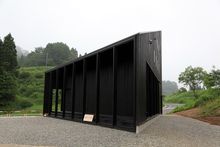
The newly built Australia House
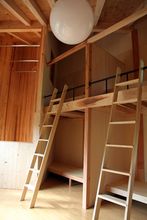
Bunks in Australia House, which sleeps six people

Trent, Andy and Ulanda explore their new digs at Australia House
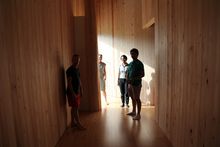
Andy, Ulanda, Yasuko and Trent bathed in the golden light of Australia House

Andy catching the last rays of the day, nearby Australia House
News
11 July 2012
Artists-in-Residence at the new Australia House
Melbourne-based artists Brook Andrew and Andrew Rewald are the inaugural artists-in-residence at the new Australia House in Urada, Tokamachi, Niigata. They will each present new works at the Echigo-Tsumari Triennale 2012, from 29 July - 17 September 2012.
Brook Andrew is an interdisciplinary artist whose work explores hidden and marginalised histories and cultures, and collective memory. Brook co-opts the tools of advertising and the media to highlight what is voiced and what is silenced in contemporary global culture.
Andrew Rewald's art practice is centred on food, its cultivation, preparation and consumption. For Andrew, food and food-related rituals represent a specific time, place and culture, and can be powerful vehicles for overcoming cultural difference.
Trent Walter is Brook Andrew's Assistant. Trent has travelled to Echigo to ensure the successful delivery of Brook's Australia House project.
Ulanda Blair is undertaking an Asialink Arts Management Residency at Australia House for the Echigo-Tsumari Trienniale 2012.
The artist-in-residency is funded by the Japanese Agency for Cultural Affairs.

News
14 November 2011
Australian artist participating in the 5th Echigo-Tsumari Art Triennale (ETAT) visits Japan

Brook Andrew, the Australian artist who will participate in the 5th Echigo-Tsumari Art Triennale, visited Japan on 14 November 2011 and met members of the Echigo-Tsumari Art Triennale Executive Committee for the first time. He will start his artwork for the ETAT from 2012. Mr Andrew will stay at Echigo-Tsumari before and after the Triennale and will create his artworks and exhibition in collaboration with the local community.
The views expressed by any contributors to this site are those of the individual contributor.










































































































